10.25.10
Posted in Weather News at 11:51 am by Rebekah
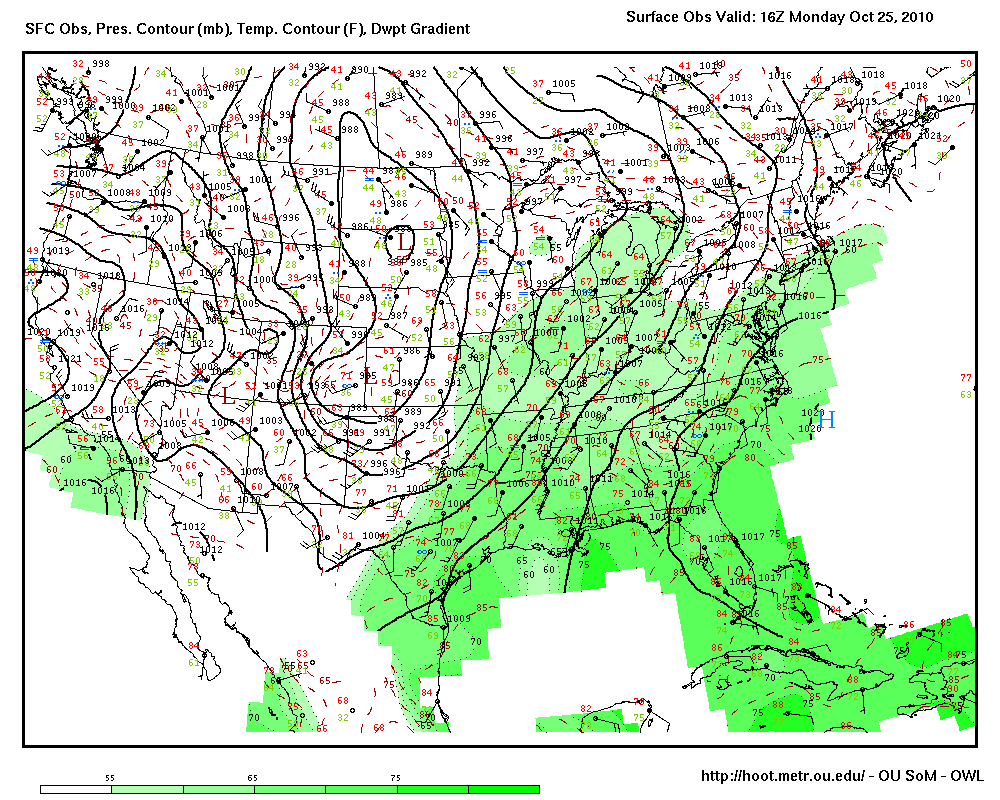
Surface observations at 11 am Central Time, from the Oklahoma Weather Lab. Click to enlarge.
A surface map of the U.S. right now shows an elongated area of low pressure over the Great Plains. The lowest pressure on this map is 984 mb.
This low pressure system is expected to rapidly strengthen today and tonight, and could even bomb out. A bomb cyclone is a mid-latitude cyclone with a pressure that drops by 24 mb in 24 hours…the GFS model (below) shows that the pressure of this cyclone could get down to 960 mb in about 24 hours.
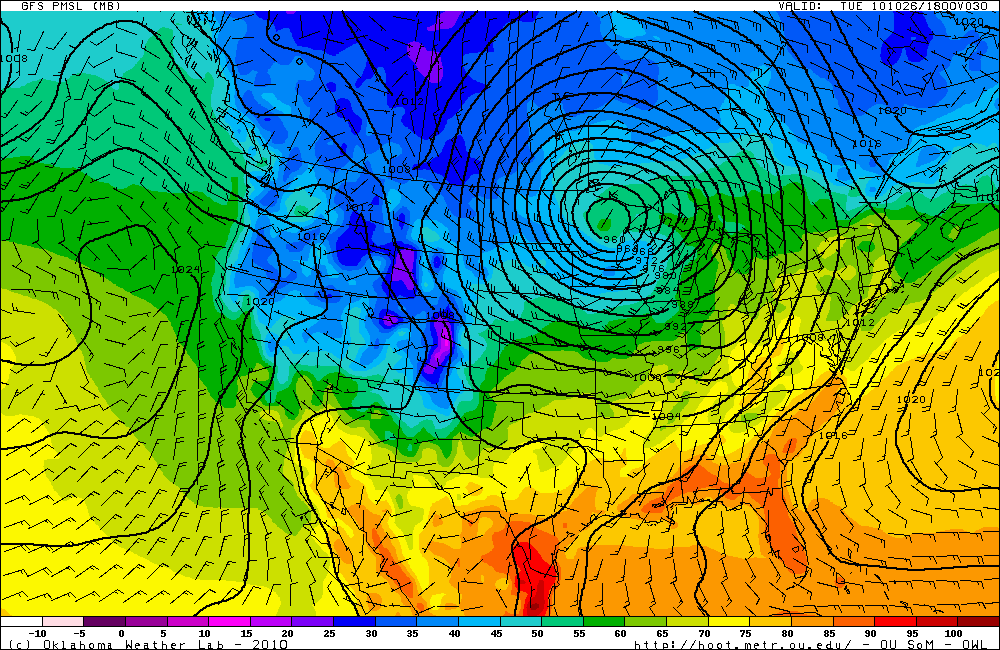
GFS model valid at 18Z (1 pm Central Time) Tuesday, showing surface pressure and temperature. Click to enlarge.
When the pressure gradient becomes this strong, the wind speeds increase. High wind watches have already been issued for much of the Midwest. The National Weather Service says that sustained winds of 4o to 50 mph are expected behind this low pressure system, and gusts could get to 55 mph late tomorrow.
A cyclone that strengthens to 960 mb over land does not happen very often. If this same cyclone occurred in another month or two, there would likely be a big blizzard. However, the air behind the cold front associated with this system is not quite cold enough for snow just yet.
For more on the how this cyclone is expected to develop, please see Jeff Makowski’s blog: Mid-week Storm
Permalink
10.22.10
Posted in Severe Weather Forecast at 11:04 am by Rebekah
The Storm Prediction Center issued a slight risk for severe weather today, with a 5% chance of tornadoes over south central Oklahoma and north central Texas.
A negatively tilted shortwave trough is located through the Texas Panhandle into central Texas, with strong upper-level winds around the base and just downstream of the trough.
An elongated surface low stretches from eastern Colorado into the Texas Panhandle, while a diffuse dryline, expected to tighten this afternoon and move eastward, is situated in the west central Texas Panhandle. There is a pretty significant wind shift along this boundary, with westerly winds in eastern New Mexico, southerly winds in the central Texas Panhandle, and southeasterly winds in the east Texas Panhandle.
Dewpoints in Oklahoma and the Texas Panhandle are in the mid- to upper 50s, but moisture is surging north and they could get into the lower 60s later today.
There is still an MCS in western Oklahoma, but the storm’s outflow boundary in western Oklahoma / southeast of the Texas Panhandle could aid in storm initiation.
There is quite a bit of cloud cover associated with the MCS, which could limit heating and instability, but skies are already clearing in some areas of northern Texas and far western Oklahoma.
CAPE values could reach 1000 or even 1500 this afternoon around Wichita Falls to Shamrock, Texas, and mid-level lapse rates are decent as well.
Vertical wind shear will certainly not be lacking…this morning’s sounding from Norman showed a perfectly curved hodograph. 0 to 6 km shear is at 50 to 60 knots over the Texas Panhandle and northern Texas, and will maintain values close to that into the afternoon / evening. Surface winds are backed over Oklahoma and north Texas, so the chance is decent for supercells to form, if storms initiate and can maintain a solid updraft.
And if supercells do form, there is a decent chance for tornadoes, given low-level wind shear and increasing moisture.
I’m not completely sold on this one yet…I have stick around here ’til 1pm anyway, and I’ll make a decision at that point. As of now, my target would probably be around Wichita Falls, Texas to Altus, Oklahoma.
If I go, it’ll be without streaming or being on Spotter Network, as I don’t want to upgrade my cell plan to tethering again for only one chase. However, I’ll keep you updated!
Permalink
10.21.10
Posted in Severe Weather Forecast, Weather News at 3:00 pm by Rebekah
There’s a slight chance for some severe weather this afternoon in west Texas into eastern New Mexico, including a chance for supercells, but today I’m going to focus on the risk for severe weather tomorrow.
I had a quick look at the 12Z GFS and NAM, and this is what I’m seeing.
There’s a stacked, closed low over Arizona right now, expected to move into eastern Colorado by tomorrow evening. Dewpoints are forecast to reach the lower 60s from Texas up into south central Kansas as surface winds will be from the south-southeast and a cold front / dryline will set up in the east Texas Panhandle. Although there will not be a ton of instability along the dryline, with CAPE values likely only in the 500 to 1500 J/kg range, there will also not be much of a cap. There will be positive vorticity advection in western Oklahoma and ample wind shear for rotating storms (the NAM has 0 to 1 km SRH of 100 to 150; the GFS and NAM have 0 to 6 km bulk shear of 35 to 50 knots centered around Wichita Falls, Texas). Hodographs in parts of western Oklahoma look pretty curved.
The primary limiting factor for severe weather is the lack of instability, largely caused by cloud cover. If sufficient heating is there for surface-based storms to form, there will be enough lift and wind shear to get some supercells and possibly even tornadoes.
There could be two plays on this setup: the possibly more obvious one, from around Lawton, Oklahoma to Wichita Falls, Texas…instability could be greater there and upper-level winds are stronger. The other target I’m looking at is in northwest Oklahoma, closer to the low. There could be enhanced lift there (as well as steeper mid-level lapse rates), enough to overcome the lack of instability.
Bottom line: there could be a decent chance for supercells tomorrow from northern Texas (Wichita Falls area) all the way up through western Oklahoma and possibly even southwest Kansas. If conditions improve by 1pm tomorrow, I may go out chasing…provided that I can make it to my target on time. I’m having lunch with a group of students and a prospective grad student until 1, so I can’t leave before then anyway.
Stay tuned!
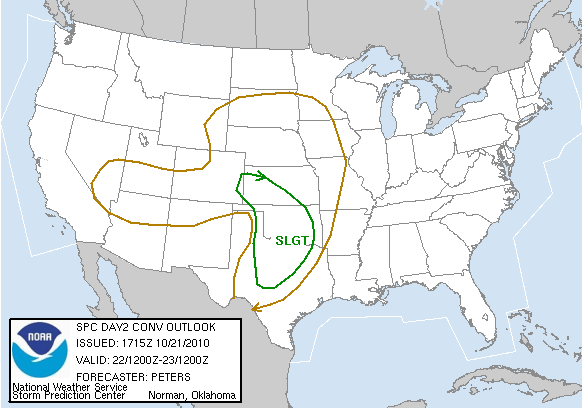
Permalink
10.19.10
Posted in Non-US Weather, Tropical Weather, Weather News at 8:06 am by Rebekah
This week’s post in the global weather and climate series features Singapore.
-
-
-

Singapore montage, from Wikipedia (click to enlarge).
Singapore is a country made up of 63 islands located at the southern tip of the Malay Peninsula. Singapore is located just 85 miles north of equator, thus the country has a tropical climate. The capital city of the country of Singapore is Singapore (the city takes up much of the land area on the main island). The country is 274 mi² with a population of 5.1 million and a population density of about 18,000 per square mile. This makes Singapore third overall in terms of population density, after Macau and Monaco (each with over 40,000 per square mile). Singapore has recently been working on land reclamation, by expanding the size of their islands and joining some islands to make more room for people.
Singapore was first founded in the 2nd century AD, but burned down by Portuguese raiders in 1613. In 1819, Singapore was discovered by the British East India Trading Company, who signed a treaty to use the area as a trading post. Singapore officially became a British colony in 1824, though it was lost to the Japanese in just 6 days in World War II. After Japan surrendered, the British regained the country. Singapore became officially independent in 1965.
Singapore is currently the world’s 4th leading financial center, has the fastest growing economy in the world, and has been ranked with the best quality of life in Asia (and 11th around the world). Tourism is important to Singapore’s economy, though the country most heavily relies on exports and refining imported goods (especially manufacturing). An estimated 42% of Singapore’s population is foreign, and foreign workers make up 50% of the service sector. There are four official languages in Singapore: English (taught in schools), Malay (national language but more symbolic than spoken), Mandarin Chinese, and Tamil.
A few more facts about Singapore (from Wikipedia):
- Time zone: Singapore Standard Time (UTC+8)
- Elevation: 0 to 545 feet
- Climate zone: Tropical rainforest
- Average high temperature: 88 °F (31 °C)
- Average low temperature: 75 °F (24 °C)
- Average annual precipitation: 85 inches (2,150 mm)
The hottest months in Singapore are May and June, with the wettest months being November and December. Relative humidity is often 90% during the morning and 60% in the afternoon. Haze is common from August to October, when smoke from bush fires in Indonesia may affect the country. Occasionally the country may be affected by typhoons, but since Singapore is so close to the equator, most storms would stay well north.
Current weather: Based on the climatology of Singapore, the recent weather is about average. Highs this week are around 90 °F, lows of 77 °F with dewpoints in the mid- to upper 70s (that’s what keeps the temperature from getting lower…it can’t drop below the dewpoint, thus the nighttime humidity could be quite high and miserable). Some rain is expected this week, though the country is not likely to be affected by Typhoon Megi.
A recent reader commented that the humidity in Singapore sometimes goes up when there’s a typhoon affecting Asia. I might first speculate that this has something to do with the wind direction. If the typhoon is, as Megi is, near the South China Sea, then the wind direction over the Malay Peninsula may be from the southwest. However, Singapore is so close to the equator, the winds would not be strong enough to affect moisture in this way.
But if the change in humidity occurs more so before the typhoon draws near land, I could speculate that this may have something to do with the weather pattern that is bringing the typhoon towards Asia. For example, if there’s a ridge of high pressure over eastern Asia (see below…upper level ridge and upper-level winds in black), the surface winds around Singapore may be more from the east (green arrows in figure below). These easterly winds are part of what would push a typhoon towards Asia in the first place. Without knowing a lot about the geography and weather patterns in southeast Asia, I would suspect that an easterly wind would bring increased moisture from the South China Sea. However, the prevailing wind direction is likely from the east anyway, so I’m not sure if this along the right lines or not.
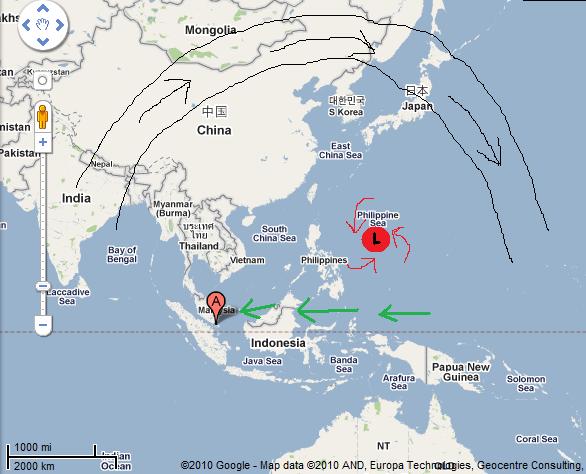
Map from Google Maps. Shows idealized wind patterns in eastern Asia, with upper-level ridge and winds in black, typhoon in red, and easterly surface winds below the ridge in green.
For weather maps and information on current and forecast Singapore weather, see the National Environment Agency (Singapore’s meteorological agency website), Weather Online UK (maps, models, and forecasts for around the world), and Weather Underground.
For more information on Singapore, here’s a link to Wikipedia.
Next Tuesday I plan to take a look at the climate and weather in another part of the globe. As always, if you have any comments or suggestions for future cities, please leave a comment!
Permalink
10.18.10
Posted in Non-US Weather, Tropical Weather, Weather News at 10:29 am by Rebekah
Super Typhoon Megi made landfall in the Philippines early this morning, on the northern end of the island of Luzon. With a reported pressure of 914 mb, Megi was one of the strongest landfalling tropical cyclones on record (Category 5 Dean in 2007 had a landfalling pressure of 905 mb).
Infrared satellite image of Megi at landfall, from Weather Underground:
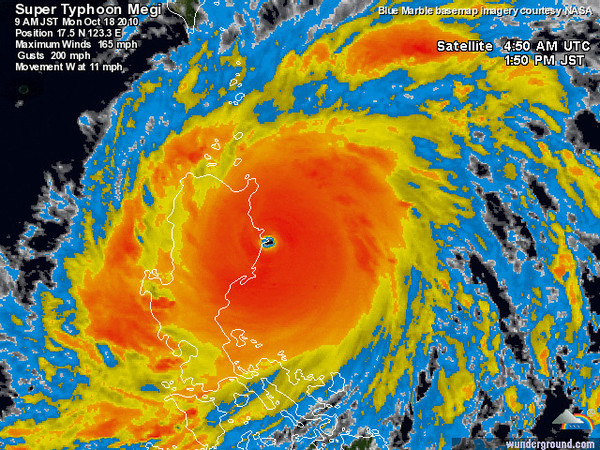
Megi bottomed out just before landfall at 885 mb, the strongest tropical cyclone since Hurricane Wilma in 2005 (882 mb, lowest pressure recorded in the Atlantic basin). Megi’s 10-minute sustained maximum winds peaked at 145 mph…1-minute sustained winds, which are used in the US to determine the ranking on the Saffir-Simpson Scale, peaked at 185 mph. Wind gusts were up to 220 mph.
Different ocean basins have different classification schemes for tropical cyclones, hence the different names. If Megi were in the Atlantic or eastern Pacific, the tropical cyclone would have been classified a Category 5 hurricane. In the waters of the western Pacific, Megi was called a “super typhoon”.
For more information on how tropical cyclones are classified based on ocean basin, see the chart on one of my previous blog entries, “Tropical Cyclone Ului Make Landfall in Australia“.
You may have heard Megi being called “Juan” as well. Megi is the “official” name for the tropical cyclone, but the Philippine Meteorological Service is calling the storm Juan. Different countries are allowed to have their own names for the storms, though the official naming goes to the World Meteorological Organization, who names the storm based on a list of names contributed to by various countries around the western Pacific.
Megi is now the equivalent of a Category 2 on the Saffir-Simpson Scale, but is expected to increase to the equivalent of a Category 4, before decreasing in intensity again and striking the south China coast somewhere just south of Hong Kong.
Weather Underground forecast track map (click to enlarge):
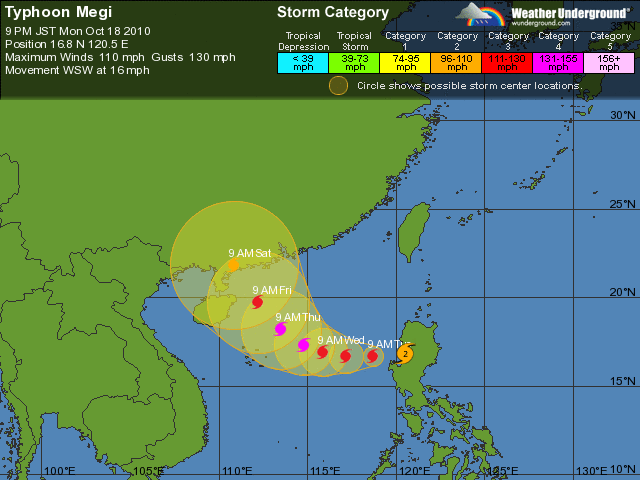
Here’s what Megi looks like right now on satellite, from Weather Underground:
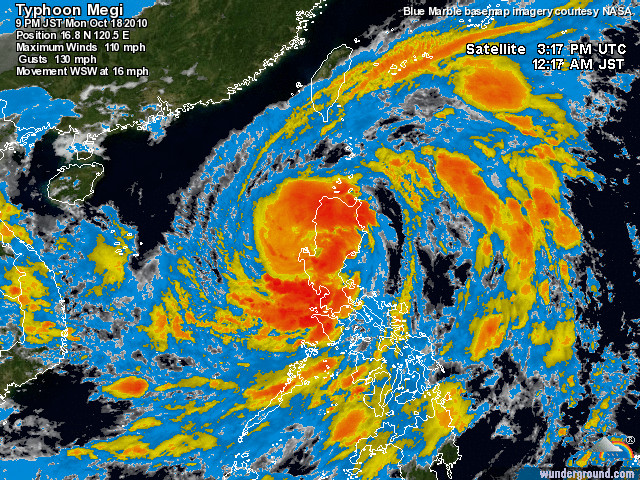
Permalink
« Previous Page — « Previous entries « Previous Page · Next Page » Next entries » — Next Page »







